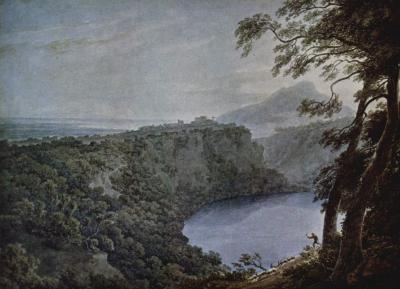Books: Haunting tribute to mysterious Roman paradise

ROME -- The former Italy correspondent for the Glasgow Herald, Margaret Stenhouse, has lived in the Castelli Romani for many years. Her love for the little volcanic crater of Nemi, 30 kilometers south of Rome, drives this wide-ranging discussion of what remains one of the most beautiful and mysterious places in the Roman Campagna. Known today for its year-round crop of tiny wild strawberries (a gift of the crater’s special microclimate), Nemi in antiquity was the site of a temple dedicated to Diana, the goddess of wild places and wild animals.
The dense forest that covered the crater’s slopes eventually parted to disclose a deep, clear crater lake, the ‘mirror of Diana,’ swarming (at least until recently) with the tiny fish called lattarini. This wilderness, at least according to an ancient legend recorded by the ancient writers Strabo, Pausanias, and Servius, was guarded by a priest-king who obtained his position by a strange, brutal ritual. If a runaway slave could find a particular heavily guarded tree in the centre of Diana’s sacred grove and break off one of its boughs, he earned the right to challenge the reigning king to mortal combat.
If the slave slew the king, he succeeded to the kingship. Otherwise, he joined the long list of human beings sacrificed to Diana. In providing a contemporary context for this remote temple and its mysterious rites, Stenhouse weaves together Nemi’s geological history, recent archaeological excavations, anthropological analysis, and history of the Grand Tour to show how the nineteenth-century Scots writer Sir James George Frazer turned the bare bones of the ancient legend of Nemi’s sacred grove into his magisterial study of religion, The Golden Bough (first published in 1890).
The layers of Nemi’s history are as deep as the volcanic fumaroles that created this evocative landscape several hundred thousand years ago, and she describes them with irresistible persuasive power. The second part of the book is devoted to two ancient Roman ships constructed by the emperor Caligula in the first century A.D., sunk beneath the waters of the lake in antiquity, and finally brought onto dry land in the 1930’s. Stenhouse plausibly connects the ships with the imported Egyptian cult of Isis, immensely popular in ancient Rome, and details the way they might have functioned on such a tiny, enclosed body of water.
The most shocking part of her story, surprisingly, is not the tale of how the ships, carefully restored and displayed in an innovative museum specifically designed around them, were destroyed by fire at the very end of the Second World War (probably by retreating Nazis, but this is not absolutely certain). Far worse than this tragic act of destruction, she seems to argue implicitly, if not explicitly, was the environmental damage that occurred as a result of the effort to raise the ships in the first place. The only way the vessels could be retrieved successfully (and even then the success was partial) was by lowering the level of the lake.
A remarkable feat of engineering, the drainage of Lake Nemi brought unforeseen consequences that were nothing short of disastrous -- subsiding soil destroyed the primeval forest ringing the lake, the lattarini disappeared with the disturbance of their environment, and the level of the lake itself never recovered.
All this for an archaeological find lost, by another act of human folly, within ten years of its discovery.
The Goddess of the Lake is a lovely guide to a singularly beautiful place, but it is also a sobering study of human preconceptions.
Margaret Stenhouse, The Goddess of the Lake: Origins of a Myth and the Roman Ships of Nemi, 2016


